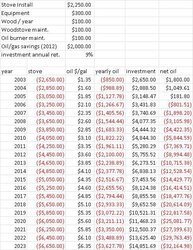I assumed $100/year for woodstove maintenance (debit) or $100/year on propane furnace maintenance (credit), so that's basically a wash. I also assumed $100/ year in wood collection costs (fuels, fluids, chains, saw depreciation & maintenance).
So, your upfront investment was $2650 (install + equipment + first year's wood costs), which you could've invested elsewhere at 9%. I didn't know what year you installed your stove, so I left that at 2003, and I also don't know what the trend on LP is (likely not the same $0.25/year linear trend oil has seen over the last ten years), but in any case...
View attachment 109923
So, based on 9% annual return, your $2650 would have been $14851 after 20 years, but after subtracting out your propane costs (again, using oil as trendline... probably very innaccurate), you'd be $32k in the hole. Meanwhile, your wood heating has cost you $6650, for the same 20 year period. You are justified!







